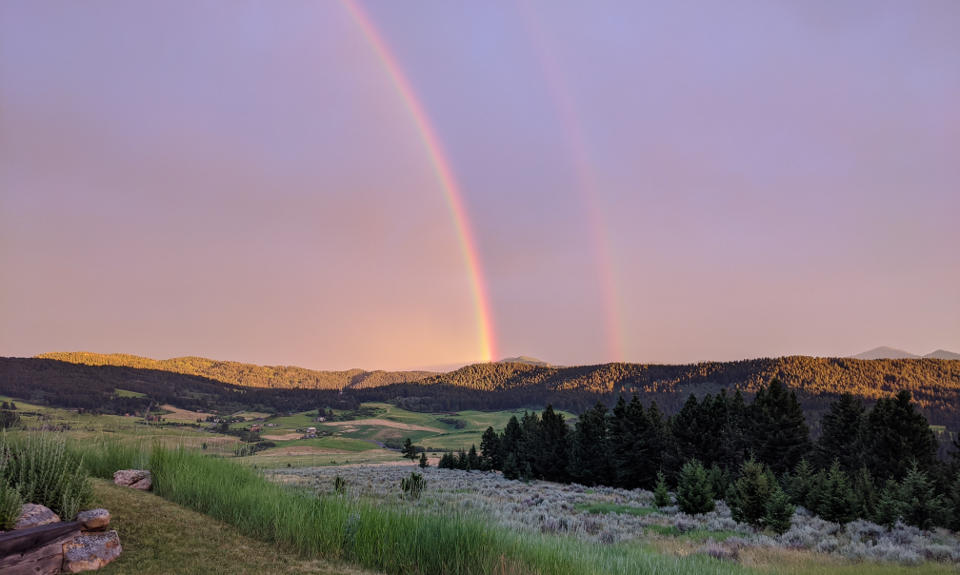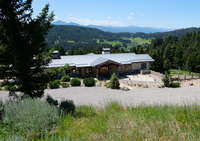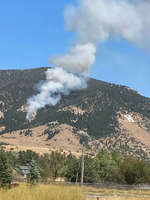⇐Last Report
⇒Next Report
July through September,
2020
Fire!

Rainbows at Sunset
We named our Montana home
“Bridger Canyon Lodge”
because we originally thought to run a B&B.
The domain name
“bclodge.com”
was reserved for that purpose.
We retained the name and the domains even though the B&B never happened.
We now use the domains to host our updates on family happenings.
Now that the property is for sale,
it was thought the term
“lodge”
could be misconstrued by prospective buyers;
a little brainstorming came up with a name for real estate marketing
purposes:
Place Creek Ranch.
The domain name
placecreekranch.com
was available so Gary bought it.
Check the second link to see Gary's first attempt at using a real
authoring tool rather than the home-brew tools he has used and is still
using for the Bridger Canyon Lodge site.

By the way,
Place Creek is the name of the year-round creek running through our
property.
In fact,
more than half of the creek is on our property.
Above the property it quickly changes to a marshy gully,
while below the property it soon empties into Bridger Creek.
Before the Christies owned the property,
much of the land in this area was owned by a man by the name of Place,
hence the name of the creek.
The end of July saw the end of major repair work on the Main House.
In particular,
the landscaping for the area over the Garage was completed to create a
xeriscaped patio.
The water from spring snow-melt should run quickly away from the house,
then west
(right of the picture).

But there is always something more to deal with.
Caretaker Claire started seeing air in the water at the Carriage House.
This caused the faucets to sputter and spit.
A plumber attributed this to a leak in the well rather than some problem
in the Carriage House plumbing.
Fortunately,
Claire's boyfriend Jim has a friend with a well drilling business and
was able to get him to squeeze us into their schedule.
The well is 17 years old now and 15 years is the life expectancy for a
well pump,
so we decided to pull and replace the pump as they inspected the system.
The pipe down to the pump was a heavy grade PVC,
but not up to the specs for a 600 foot deep well.
We wound up replacing the PVC with galvanized pipe.
We're not sure exactly what caused the problem at the Carriage House,
but the new pump and pipe cured it.
And,
the new pump increased the sustained flow from 15gpm to 20gpm at the
Carriage House.
Getting the water up an additional 60 feet of elevation and through
another 600 feet of 1¼
inch pipe to the Main House reduces our flow to about 12gpm —
more than enough to keep the Main House reservoir full.

September 2 was the
anniversary
of daughter-in-law Kristy's death.
Many family members shared a moment of silence to commemorate the sad
occasion.
The boat fire was one of the worst tragedies to befall Santa Barbara
and the city conducted several observances of the tragedy;
we were able to watch these via video streams.
Sons Paul and Dan joined a large group of divers representing the many
people who died for a dive at the accident site.
There is a memorial plaque on the sea floor at the site listing the
names of the victims.
Dan posed for this picture next to the plaque.
There is a similar plaque at the breakwater in the harbor in Santa
Barbara.

On September 4 we got a text from Claire that included a picture of a
small plume of smoke near the
“M”
(a large letter M on the west mountainside at the entrance to the canyon).
We went outside to see the plume had grown to be visible over our side
(east)
of the canyon wall.
While the fire was on the west side of the ridge,
we knew it was less than 3 miles away and could move fast if it got over
the ridge into the canyon.
We started collecting things to take with us,
watching the smoke over the ridge grow more ominous.
Firemen stopped by and commented that our house would be easy to defend.
We left when we could see flames on the ridge top starting to descend
onto our side of the ridge and into the canyon.
We started to take Claire's dog as we left,
but Claire arrived and took over evacuation of the Carriage House.
Our preferred evacuation vehicle is our little RV.
We camped that night in a friend's driveway on the west side of the
ridge and safely away from the fire.
The next morning
(September 5)
we were informed we could return to our house for a short time.
The fire had not progressed very far down our side of the ridge and it
was looking like the air tankers and helicopters were getting the fire
under control.
Firefighters again dropped by and told us to be out of the canyon by
noon because the wind would be picking up.
We quickly gathered up more
“valuables”
and retired to our friend's driveway for a short rest.
At about 1pm we went to Arthur's house for lunch.
As we drove we could look back to the west side of the ridge and see a
mushroom cloud of smoke looming over it.
The fire on the west side had been mostly extinguished;
all the smoke was from the fire raging on our side.
The wind was now pushing the fire up the canyon,
toward our house,
at a furious rate.

That afternoon and evening we watched
(remotely)
the video from our front security camera as the fire raced through the
homes north of us.
The fire grew from 400 acres to over 7,000 acres in six hours.
As it turns out,
the houses immediately north of us were spared,
but homes north of them were reduced to ash.
We could hear helicopters on our security camera –
they were carrying water from ponds on the canyon floor up to our
property and to the homes immediately north of us.
We later learned that when we were told to evacuate,
the homeowners further up the side of the canyon were being told it was
unlikely their homes could be saved.
We assume there were not enough helicopters to carry water further up.
Those who have not seen a fire burn through a dry forest cannot appreciate
how it does not advance slowly and remorselessly —
it advances as trees literally burst into flames as their needles catch
fire,
as in the picture.
It is somewhat like spraying gasoline onto your charcoal grill.
Forest fires also advance by
“spotting”
as wind blows embers well ahead of the fire to start many small fires.
Our video feed ended when power to the canyon was turned off by
firefighters.
We were able to confirm our house was at least partly OK by calling the
home phone to see if the answering machine was operational.
Late the next day the UPS powering the answering machine ran out of
juice and we started calling friends across the canyon who were not
evacuated.
Fire and smoke obscured their view but we were eventually able to get
confirmation our home appeared to be safe.
Once power was restored we were able to get views from the security
camera again and things looked good.
If the camera had been pointing more to the right the view would have
been very different!

We later learned the fire had raced north of the house,
then part of it turned back along Bridger Canyon Road while another arm
continued to expand northward.
When we finally got a chance to see the house,
we saw the grass all around had burned but the grass near the house
(aka lawn)
was too short to sustain fire.
We also learned firemen and neighbor volunteers had pitched in to save
the Carriage House and even our little Garden Shed.
The Storage Shed up the old road was not threatened.
Firemen were able to use our driveway as a fire break to keep the fire
from spreading further back down the canyon.
At one point a helicopter may have dumped water on one of our structures
to protect it.
So,
none of our structures were lost or damaged.
The fire
destroyed 30 homes,
damaged 6 homes,
destroyed numerous other structures and damaged many miles of fences.
There were no serious injuries,
but three firefighters had to deploy their
shelters
and let the fire burn past them.
Subsequent walks around the remote western parts of our property have
revealed numerous spot fires the firemen on the ground or in helicopters
must have put out.
Their efforts prevented what would otherwise have been extensive loss of
our forest and kept the fire from spreading back north into Bridger
Hills to threaten homes not consumed by the fire that had raced through the
day before.
If you click through to the large version of the picture,
you will see white patches on the canyon wall north of the house.
On September 7 the fire was slowed down by a cold front that brought
rain,
plus some snow at higher elevations.
Temperatures soon returned to normal and it is expected the remnants of
the fire will continue to smolder and possibly reignite until there is
significant snowfall.

As our part of the fire area became safer,
we were allowed back in for specified times.
We spent that time with Claire and Jim putting out smoldering stumps below
the house and around the Carriage House,
and spent our nights at our friend's house.
We finally moved back into our house on September 9,
and celebrated Gary's birthday with members of our
“COVID Bubble”
on our east patio September 13.
Now to start cleaning up the mess!
Sidebars

Our Driveway Served as a Firebreak
The driveway was a convenient firebreak to keep the fire from spreading
west (left in the picture).
Many trees on the right of the driveway were spared due to work we had
done years ago to remove lower branches and reduce the chance that fire
would spread from the grass into the branches.
Hopefully many of these trees will survive.
This picture was taken from across Bridger Canyon Road looking north.
⇐ Last Quarter
BCL Home
Next Quarter ⇒









